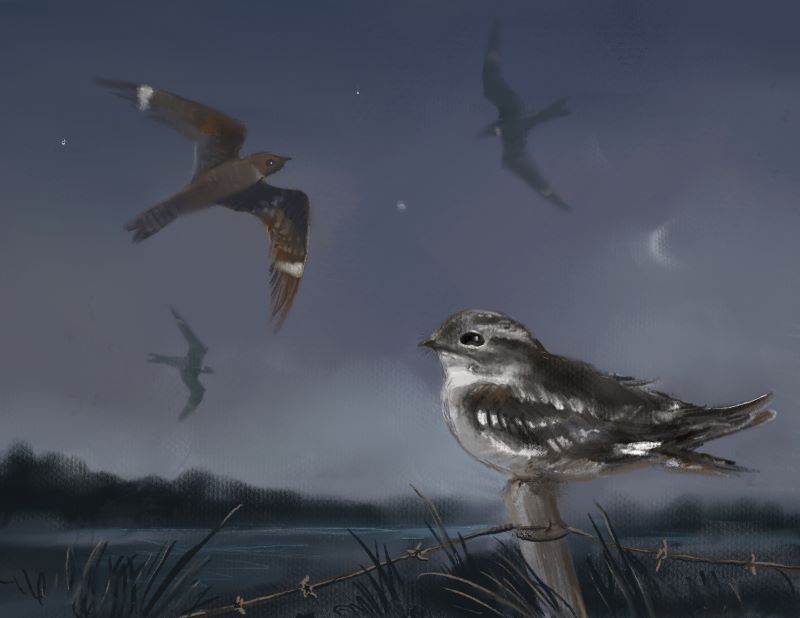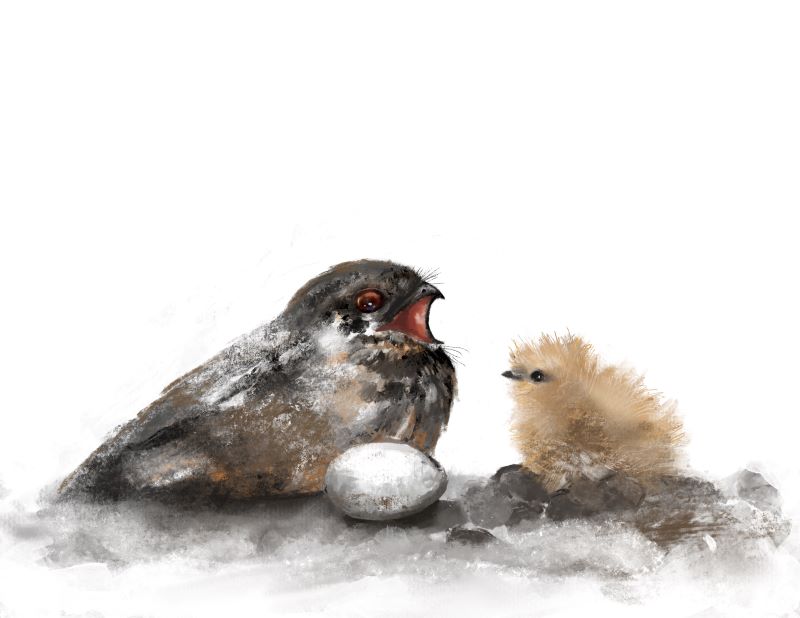
In the quiet silent seconds I turned off the light switch
And I came down to meet you in the half light the moon left
While a cluster of nightjars sang some songs out of tune
A mantle of bright light shone down from a room…
—Elton John, Come Down in Time
It’s said that hearing the call of the nightjar foretells death or misfortune, but it can also bring good fortune, and can even grant one’s heart’s desire, if one wishes when one hears the first poorwill of the year. One thing is true about this small mysterious bird, one is far more likely to hear it than see it, regardless of what its call portends.
The Caprimulgiformes, or nightjars, share many traits in common with owls—velvety feathers that enable them to fly silently, large eyes adapted to see in the dark, and distinctive calls that are the stuff of folklore, but they belong on their own branch of the avian family tree. Nightjars are the original chupacabras, or goat suckers—that’s what the scientific name for the family—Caprimulge—means—but these secretive birds prey on insects, not mammals, and are entirely benign and beneficial.
The official NPS species checklist for the Santa Monica Mountains National Recreation Area includes three species of nightjar: the common nighthawk, the lesser nighthawk, and the common poorwill, but two thirds of that list appear to be wishful thinking. The author has seen a lesser nighthawk here just once, at the Malibu Lagoon. The recent sighting of four of these birds at the Santa Fe Dam in Irwindale warranted a spot in the Los Angeles Audubon Society’s rare bird alert earlier this year. They were probably transients, on their way to breeding grounds farther north. There are no records of anyone encountering a common nighthawk in the Santa Monica Mountains or much of Los Angeles County in recent years. These species are more abundant in other areas, but appear to be extirpated from our mountains, or extremely rare here.

There is only one member of the nightjar family that makes its home year round in the Santa Monica Mountains: the common poorwill, Phalaenoptilus nuttallii, the smallest North American nightjar. The common poorwill isn’t rare, but it’s very good at hiding in plain sight. Cryptic coloring enables this species to be almost invisible during the day. It’s a necessary survival adaptation, because these birds nest on the ground, and are highly vulnerable to predators.
The poorwill’s distinctive and mournful call is the source of its a hiker, returning late from a ramble in the hills, may feel the soft fluttering of the poorwill on the trail in the darkness, like a dried leaf carried by the wind. The bird’s eyes are highly reflective, glowing in the beam of a flashlight are the only part of the bird visible in the dark. That glowing eye, the eerie call, and the bird’s ability to open its mouth astonishingly wide have all contributed to its supernatural reputation, but the only things threatened by the poorwill are insects like mosquitoes.
The poorwill has another remarkable adaptation: it can hibernate during cold weather when insects are scarce, lowering its heart rate and its body temperature for days or even weeks.
The first half of the scientific name for the common poorwill, Phalaenoptilus means moth-winged. Like true owls, the common poorwill’s feathers have a velvet-like texture that enables them to fly silently (the second half, nuttallii, honors British botanist, zoologist, and explorer Thomas Nuttall, 1786–1859)—almost always an indicator that a species is native to Western North America and that it wasn’t described until the last half of the nineteenth century.
While this bird is seldom seen, even when almost underfoot, it isn’t unusual to hear one in the dark. The common name is onomatopoeic, although “poor will” does nothing to convey the eerie beauty of this bird’s call. Poorwills are more vocal during mating and nesting season in the spring, but it is possible to hear their ghostly call on almost any summer night in Topanga, where they still remain relatively abundant in the shelter of Topanga State Park and other undeveloped areas. Take a moment to listen for the call of “poor will, poor will, poor will-ow,” and if you hear it, don’t forget to make a wish—it might come true.




